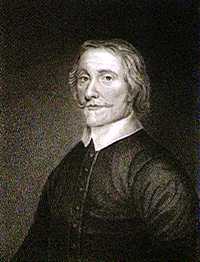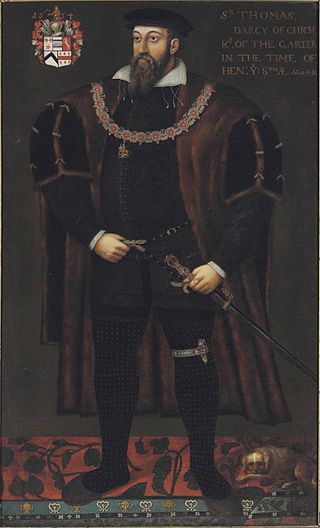Related Research Articles

Viscount Cobham is a title in the Peerage of Great Britain that was created in 1718. Owing to its special remainder, the title has passed through several families. Since 1889, it has been held by members of the Lyttelton family.

Baron Dacre is a title that has been created three times in the Peerage of England, every time by writ.

Baron Stafford, referring to the town of Stafford, is a title that has been created several times in the Peerage of England. In the 14th century, the barons of the first creation were made earls. Those of the fifth creation, in the 17th century, became first viscounts and then earls. Since 1913, the title has been held by the Fitzherbert family.

Earl of Strafford is a title that has been created three times in English and British history.

Viscount Valentia is a title in the Peerage of Ireland. It has been created twice. The first creation came in 1621 for Henry Power. A year later, his kinsman Sir Francis Annesley, 1st Baronet, was given a "reversionary grant" of the viscountcy, which stated that on Power's death Annesley would be created Viscount Valentia. Annesley, a member of an influential Anglo-Irish family which descended from Newport Pagnell in the County of Buckinghamshire, was a favourite of James I, who granted him land in Ireland, notably the fort of Mountnorris in County Armagh. He was knighted in 1616, created a baronet, of Newport Pagnell in the County of Buckingham, in the Baronetage of Ireland in 1620 and Baron Mountnorris, of Mountnorris in the County of Armagh, in 1628.

Baron Sheffield is a title that has been created four times: once in the Peerage of England, twice in the Peerage of Ireland, and once in the Peerage of the United Kingdom.

Baron Hunsdon is a title that has been created three times.

Viscount Grandison, of Limerick, is a title in the Peerage of Ireland. It was created in 1620 for Sir Oliver St John, the Lord Deputy of Ireland. He was the descendant and namesake of Oliver St John, whose elder brother Sir John St John was the ancestor of the Barons St John of Bletso and the Earls of Bolingbroke. Moreover, St John's nephew Sir John St John, 1st Baronet, of Lydiard Tregoze, was the ancestor of the Viscounts Bolingbroke and the Viscounts St John.

The title of Viscount Lisle has been created six times in the Peerage of England. The first creation, on 30 October 1451, was for John Talbot, 1st Baron Lisle. Upon the death of his son Thomas at the Battle of Nibley Green in 1470, the viscountcy became extinct and the barony abeyant.
The Baronetcy of Temple, of Stowe, in the Baronetage of England, was created on the 24th of September 1611 for Thomas Temple, eldest son of John Temple of Stowe, Buckinghamshire. His great-grandson Sir Richard, 4th Baronet, was created Baron Cobham on 19 October 1714, and Viscount Cobham and Baron Cobham on 23 May 1718, the latter with a special remainder, failing his male issue to his sisters and their heirs male. Upon his death on the 13th September 1749, the barony of 1714 became extinct. Both the viscountcy and barony of 1718 passed to his elder sister, and the baronetcy passed to his second cousin once removed William Temple, of Nash House, who became 5th Baronet. On the death of Sir William's nephew Sir Richard Temple, 7th Baronet, on 15 November 1786, the baronetcy became dormant.
The title Earl of Holderness also known as Holdernesse existed in the late 11th and early 12th centuries as a feudal lordship and was officially created three times in the Peerage of England namely in 1621, in 1644 as a subsidiary title to that of the then-Duke of Cumberland and in 1682. The official creations lasted 5, 38 and 96 years respectively.
Baron Darcy may refer to the following baronies:
Viscount Savage was a title in the Peerage of England. It was created in 1626 for Sir Thomas Savage, 2nd Baronet, husband of Elizabeth Savage and heir-apparent by special remainder to his father-in-law's titles of Baron Darcy of Chiche (1613), Viscount Colchester (1621) and Earl Rivers (1626).

Baron Sydney was a title that was created three times in British history. The title was later elevated twice into a viscounty, and from there, once more into an earldom.

Earl of Peterborough was a title in the Peerage of England. It was created in 1628 for John Mordaunt, 5th Baron Mordaunt. He was succeeded by his eldest son, Henry, the second Earl. He was a soldier and courtier. Lord Peterborough had two daughters but no sons. He was succeeded in the barony of Mordaunt by his daughter, Mary, 7th Baroness. The earldom was passed on to his nephew, Charles Mordaunt, 1st Earl of Monmouth, who became the third Earl. He was a prominent soldier and politician. In 1705 he also succeeded his cousin Mary in the barony of Mordaunt. His eldest son John Mordaunt, Viscount Mordaunt, predeceased him, and Lord Peterborough was consequently succeeded by his grandson, Charles, the fourth Earl. The barony of Mordaunt, the viscountcy of Mordaunt and the earldoms of Peterborough and Monmouth, became extinct on the death of the latter's son, the fifth Earl, in 1814. The barony of Mordaunt was passed on to his half-sister, Lady Mary Anastasia Grace Mordaunt.

Baron Wentworth is a title in the Peerage of England. It was created in 1529 for Thomas Wentworth, who was also de jure sixth Baron le Despencer of the 1387 creation. The title was created by writ, which means that it can descend via female lines.
Baron Darcy of Chiche was a title in the Peerage of England.

Thomas Darcy, 1st Baron Darcy of Chiche KG was an English courtier during the reign of Edward VI. He served as Vice-Chamberlain of the Household and Captain of the Yeomen of the Guard between 1550 and 1551 before his appointment as Lord Chamberlain of the Household. He was placed under house arrest for his support of Lady Jane Grey as Edward's successor.
Thomas Darcy, 1st Earl Rivers was an English peer and courtier in the reigns of Elizabeth I, James I and Charles I.

Thomas Savage, 1st Viscount Savage, 2nd Baronet, was an English peer and courtier in the reign of Charles I.
References
- 1 2 One or more of the preceding sentences incorporates text from a publication now in the public domain : Chisholm, Hugh, ed. (1911). "Rivers, Earl". Encyclopædia Britannica . Vol. 23 (11th ed.). Cambridge University Press. p. 385.
- "Rivers, Earl (E, 1626 - 1737)". Cracroft's Peerage. Archived from the original on 5 June 2012. Retrieved 5 February 2011.